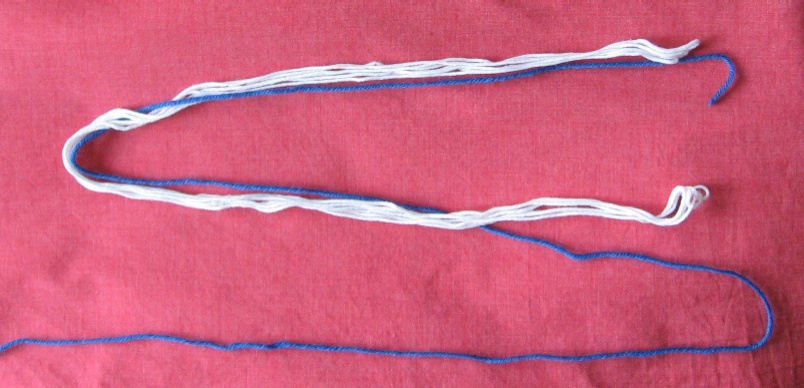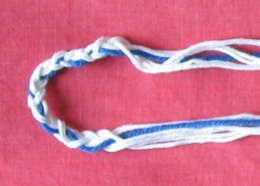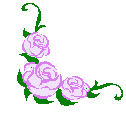Tsitsit
A sign of flourishing,
to
remember the blessing and reigning hand of YaHUaH
André H. Roosma
28 April 2012
Sometimes people ask me, “what is that kind of fringe you are
wearing from a belt loop of your pants?”
When I tell them it is a Tsitsit, I often
get a glazy eye, or someone will say, “are those some kind of
Jewish tassels? But, aren’t those supposed
to be on the four corners of a Jewish prayer shawl only?”
Time for a little bit of explanation.
What is that, a Tsitsit, Hebrew: צִּיצִּת
, and what are they good for?
A Tsitsit (6734) (fem. sing.;
plural: Tsitsiyot) is a kind of fringe, also called tassel.
The old Semitic script that I studied1 makes it rather clear what a Tsitsit is. In that script, the word Tsitsit is written as:     .
It is related to the word Tsits: .
It is related to the word Tsits:    - literally: something that bots out (extrudes) (
- literally: something that bots out (extrudes) ( ) from the branch ( ) from the branch ( ) of a plant ( ) of a plant ( ).
This represents a brightly colored flower or anything that is glistening
in the sun, like the stems or ears of reed or wheat do when they are ripe. ).
This represents a brightly colored flower or anything that is glistening
in the sun, like the stems or ears of reed or wheat do when they are ripe.
A Tsitsit then is a mark ( ) of that;
a sign that we are colorfully flourishing or glistening in the bright light of
YaHUaH, our God. ) of that;
a sign that we are colorfully flourishing or glistening in the bright light of
YaHUaH, our God.

A passage from Numbers 15: 37-41 gives the Israelites the instruction to
attach them to their clothes, providing also the reason to do so:
YaHUaH said to
Moses, “Speak to the people of Israel, and bid them to make tassels [lit:
Tsitsit] on the corners of their garments throughout
their generations, and to put among [or:
around] the tassel [Tsitsit] of each corner a cord of sky blue;
and it shall be to you a tassel [Tsitsit] to look upon and remember
all the commandments of YaHUaH, to
do them, not to follow after your own heart and your own eyes, which you
are inclined to go after wantonly. So you will remember and do all my
commandments, and be holy to your God. I [am]
YaHUaH your God, Who brought you out of
the land of Egypt, to be your God: I [am] YaHUaH your God.”
So, every morning when we put on our clothes with one or more Tsitsiyot on them, we are reminded that YaHUaH, our God, is right there with us –
on every side of us.
That will determine or ‘color’ our day and everything we think,
feel and do that day.
Speaking about color, that special heavenly or sky blue thread in or around
the Tsitsit is quite significant!
It’s color is to be תְּכֵלֶת
- Tekhelet (8504)
- a heavenly or sky (violet-ish / indigo) blue.
In the old script:     .
Here we see the blessing and authoritative or protecting hand of the great
Shepherd or Leader, surrounded by His signature: the cross, in twofold.
The heavenly sky blue color reminds us that not only is YaHUaH, our God, right there with us, but that He is there
to bless, to protect and to empower us. Only He makes it possible to change
from the inside out, such that we flourish and thrive in His light, walking
along the path after His Torah or wholesome life
directions. .
Here we see the blessing and authoritative or protecting hand of the great
Shepherd or Leader, surrounded by His signature: the cross, in twofold.
The heavenly sky blue color reminds us that not only is YaHUaH, our God, right there with us, but that He is there
to bless, to protect and to empower us. Only He makes it possible to change
from the inside out, such that we flourish and thrive in His light, walking
along the path after His Torah or wholesome life
directions.
In Deuteronomy 22: 12, another word is used for the Tsitsit. That is: גְּדִל -
gedil (1434) -
twisted threads, tassels.
Or, in the old script:    . This signifies: to go to the door of the great Shepherd,
or to support the entering of the great Shepherd.
It reminds me of what Jesus / Yashu‘ah said in
Revelations 2, that He knocks at our door, but we have to open it.
The gedil indeed helps us to do just that, on a
daily basis! . This signifies: to go to the door of the great Shepherd,
or to support the entering of the great Shepherd.
It reminds me of what Jesus / Yashu‘ah said in
Revelations 2, that He knocks at our door, but we have to open it.
The gedil indeed helps us to do just that, on a
daily basis!
When we wear them, we are in good company, for, read what the Bible says
about Jesus / Yashu‘ah
Himself:
And behold, a woman, who had suffered from a
hemorrhage for twelve years, came up behind Him, and touched the fringe [the Tsitsit] of his garment: for she
said to herself, “If I only touch his garment, I shall be made
whole.” Jesus turned and seeing her He said, “Daughter, be of good
cheer; your faith has made you whole.” And the woman was made whole at
that moment. Mattit-Yahu (Matthew) 9: 20-22
And when they had crossed over, they came to land at
Gennesaret. And when the men of that place recognized Him, they sent round to
all that region and brought to Him all that were diseased, and begged Him that
they might only touch the fringe [the Tsitsit] of his garment; and as many as touched it were made
well. Mattit-Yahu 14: 34-36
These passages (see also Marc 6: 56) clearly
demonstrate that Jesus / Yashu‘ah Himself wore a Tsitsit (either one or
more) on His clothes, that people saw precisely that as a sign of
God’s healing presence, and that God used that. Is it wrong to go in
Yashu‘ah’s footsteps
and follow Him in this?
For a close:
Do I wear a Tsitsit on my clothes as
a law-demanded obligation? No, very far from that ! I wear them out of
great joy and to celebrate my great Lord, Master and heavenly Father, Whom
is so great to be around! In His marvelous Light I love to glisten!
He is worth it!
Hallelu-YaH!
Notes
| 1 |
More information on the oldest pictographic Bible
script in: André H. Roosma, ‘The Written Language of Abraham, Moses and David –
A study of the pictographic roots and basic notions in the underlying fabric
of the earliest Biblical script’  , Hallelu-YaH Draft
Research Report, 1st English version: 18 April 2011
(1st Dutch original: January
2011). , Hallelu-YaH Draft
Research Report, 1st English version: 18 April 2011
(1st Dutch original: January
2011). |
| 2 |
My dictionary says that the first two letters
are possibly a later corruption, and that originally it was שׁחלת
(shechelet), that is,     . This gives an etymology of the color designation, via the reference
to the color of the vault of heaven (the sign of the source of the tent cloth
of the great Leader). This denotes that the color refers to the sky, that is,
to God. . This gives an etymology of the color designation, via the reference
to the color of the vault of heaven (the sign of the source of the tent cloth
of the great Leader). This denotes that the color refers to the sky, that is,
to God.
According the Hebrew
Wiki it corresponds to  - azure blue; with
RGB coordinates: (0,127,255). - azure blue; with
RGB coordinates: (0,127,255).
There are Jewish laws prescribing the
exact dye to be used. This is extracted from a rare sea snail –
which, according to the Torah of God is an unclean animal (rendering
this prescription very doubtful...)! |
In Exodus 28:36 and 39:30, as well as in Leviticus 8:9,
the word ציצ - tsits is used for the golden diadem, rosette or crown that the High
Priest was wearing on his forehead, with the text: ‘holy unto (or:
consecrated to) YaHUaH’. The Treasure of Scripture Knowledge
says about it: “The word tzitz which we translate a plate,
properly signifies a flower. It is rendered by the LXX petalon - a leaf,
and is called nezer - a crown in ch. 29:6 and diadema - a diadem,
by the author of the book of Wisdom, ch. 28:24. Josephus says that it was
adorned with three rows of the flower which the Greeks call kyanos.
It was two fingers broad, of a circular form, suited to the shape of the head,
and so long that it reached from ear to ear, and was fastened upon a blue lace
or ribband, which was tied behind the head; and as the plate reached only
half round the head, the remaining part of the ribband was highly ornamented
with artificial flowers.”
Plinius, a contemporary of Josephus, used the
name kyanos for a kind of Iris or for the blue corn-flower. The latter
would fit very well with the two grain stalks in the name in the old symbols,
as well as concerning the sky-blue color.
What I consider remarkable, is the given that, for the wearer (as well as
onlookers) the tsits was a glorious and worthy sign of his or her
attachment and being consecrated to God YaHUaH.
See also: Tassels for Today and the Wikipedia article about
Tzitzit.
Often the sky blue thread in a Tsitsit is
wrapped around the other threads at four places in such a way that these
windings represent the letters of the glorious Name of God: יהוה /     - Y-aH-U-aH.
In this way, the attention of the one wearing Tsitsiyot is focused
once more on the wholesome presence of YaHUaH. - Y-aH-U-aH.
In this way, the attention of the one wearing Tsitsiyot is focused
once more on the wholesome presence of YaHUaH.
Make your own Tsitsiyot
In case you would like to make your own Tsitsiyot, here is how you can:
(See also this page or this page for instructional videos, though you may

the
materials are ready |
use a different number of threads.)
Take 6 white threads and 1 sky blue (or violet blue / indigo) one.
Mostly cotton or wool is used (any thickness will do, most prefer crochet
thread, sometimes tapestry yarn; the material must fit the clothes you want to
attach them to; of the same [single and preferably natural] fabric, that is).
The white threads about 80 cm. (32 inches) long

the middle already braided |
and the blue one about 1.30 m. (52 inches) long.
Take them together, letting the blue one stick out at one end.
Take the mid-point of the white ones. This will be the point where you will
attach the Tsitsit to your clothes.
Braid or twine them all 7 together for about 5 cm (2 inches) each
way from this mid-point.
Now bind the two sets of 7 threads together in a simple double
(square) knot.
Take the long blue thread apart and wrap it around the 12 + 1 other
threads 10 times;

after 1st knot, 10 windings
blue and a half knot |
this signifies the letter י (Yod), the 10th letter
of the Hebrew aleph-beth, and the first letter of the glorious
Name of God as mentioned above.
Now let the blue thread join the others, split the set in two sets of 7
each, and bind those together again.
Take the long blue one apart again and wrap it around the 12 + 1 other

the
Tsitsit is ready |
threads 5 times; this signifies the letter ה (Hey or aH), the 5th
letter of the Hebrew aleph-beth,
and the second letter of the glorious Name of God.
Then again a knot, and again a winding of the blue thread, now 6
times for the letter ו (wau);
again a knot and another 5 windings for the final ה (Hey or aH).
Finish it off with a double knot and cut all threads at equal length.
You can now fasten it through any hole, or around a belt.
The symbolism of starting with 6 white threads and 1
blue one is firstly the 6 work days and 1 special day to engage in heavenly
things; in addition: after the first knot you will have 12 white threads (12
tribes of Israel with their own area, or 12 first disciples of
Yashu‘ah), plus a sky blue one (the tribe of Levi as
priests pr Yashu‘ah Himself, respectively) and a sky blue
one (God the Father / the Holy Spirit) around them all.
It is also possible to make a thinner Tsitsit with only 3 whites and one heavenly blue thread; in that case the
long blue one is wrapped around seven (fullness) others.
By default a Tsitsit is fixed to all 4
corners of a garment. Because most of my garments do neither have corners and
nor do I want to brag about wearing Tsitsit
too much (Mat.23:5), I often attach just one or two to the belt loops of my
pants - quite enough to remind me of His presence all the time!
Joel
Wonderful article! Thank you so much for sharing this.
André
Thanks for your encouraging reaction, Joel.
God bless you!
The previous article was: Psalm 118 –
A wonderful, prophetic-Messianic Hallel Psalm around Pesach.
|






